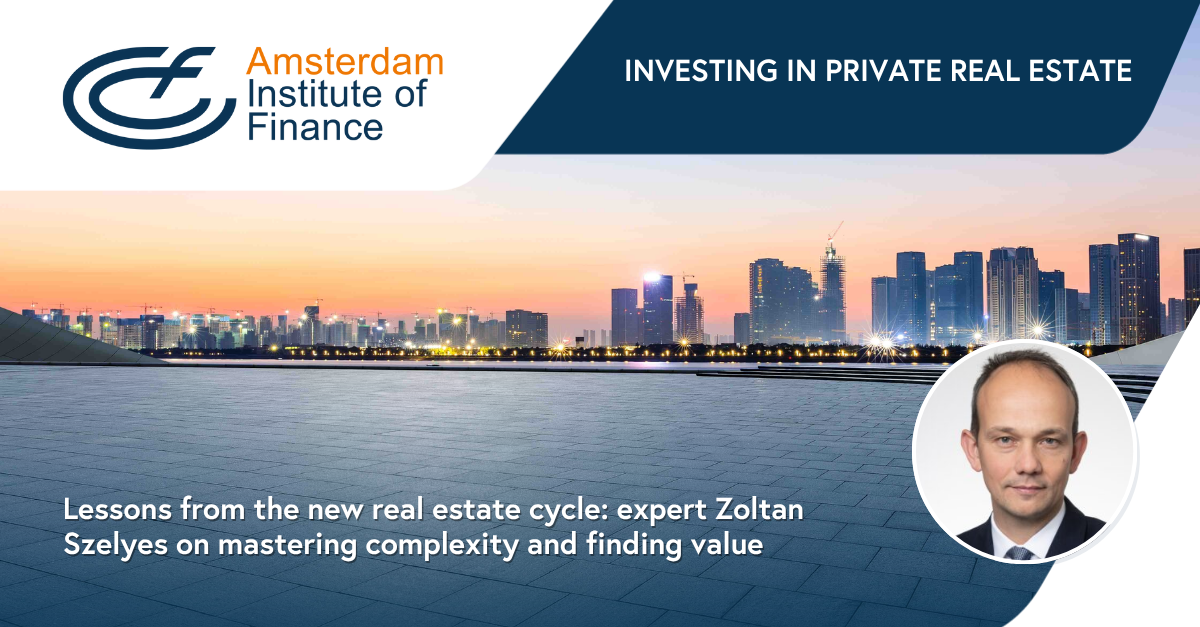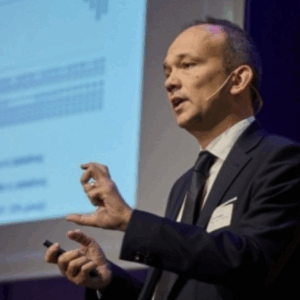
How shifting market dynamics, valuation challenges and global divergence are redefining private real estate investing.
With structural shifts, valuation gaps, and global divergence reshaping property markets, international real estate expert Zoltan Szelyes urges institutional investors to strengthen their understanding of private real estate. Now more than ever.
Long valued by institutional investors for its diversification, inflation protection, and steady long-term returns, private real estate is entering a new and more complex phase. Yet as valuations soften and macro conditions evolve, professionals across asset management, pension funds, and family offices are being forced to rethink their strategies and their assumptions.
Few experts combine macroeconomic depth with hands-on investment experience like Zoltan Szelyes, CFA, CAIA, CEO of Macro Real Estate AG and former Head of Global Real Estate Research at Credit Suisse Asset Management. Together with Professor Cyril Demaria, he co-teaches the AIF program Investing in Private Real Estate. We posed him five pressing questions on valuation, market dynamics, and the tools professionals need to navigate complexity and uncover opportunities in today’s real estate markets.

“You need to understand and bridge both macro and micro. Combining them is the key to success.”
– Zoltan Szelyes, CFA, CAIA, CEO of Macro Real Estate AG
The conversation began with the broader shifts transforming private real estate, and why this moment matters for institutional investors.
The big picture: a pivotal moment for private real estate
Zoltan, private real estate has become a cornerstone of institutional portfolios, yet the market is shifting fast. What makes this the right moment for professionals to deepen their understanding of private real estate, and where do you see the biggest structural changes in the coming years?
“With institutional investors allocating over 10% to real estate, and significantly more in certain segments and countries, the asset class remains a core component of diversified portfolios. That said, the past few years have been choppy, and some investors have trimmed exposure. This is a pivotal moment to close knowledge gaps. By understanding where the most attractive opportunities lie, and what to avoid, investors can treat today’s softness in values as an entry point.
However, the backdrop remains complex and risky. Structural forces, including shifting geopolitics and ongoing technological disruption, will likely persist for years and affect performance by sector. Agility and a readiness to adapt to changing conditions are therefore essential. Not all investment structures have adjusted market values properly, so as an investor I also need to have a deep understanding of valuation practices and behavioral biases.”
From macro to micro: where complexity arises
You’ve led global real estate research at Credit Suisse and advised institutional investors worldwide. What are the most common blind spots you see in how investors analyze or value real estate funds and markets today?
“One of the biggest challenges is that you need to understand and bridge both macro and micro. There are good top-down researchers and there are good bottom-up people. But combining both is the key to success. Unfortunately, many investors are following pro-cyclical investment strategies.
So understanding the impact of vintage on the performance and what are the true drivers of returns will be important. At the same time you can have a good idea but then lack the best execution of it. So you also need to get the basics right, the nitty gritty, in deal-level and fund-level due diligence.”
Program highlight: Investing in Private Real Estate
Together with Professor Cyril Demaria, Zoltan Szelyes co-teaches Investing in Private Real Estate at the Amsterdam Institute of Finance. This intensive two-day program bridges theory and practice through case studies, valuation simulations, and applied exercises, helping participants translate insights directly into investment action. Learn more & enroll.
Investing in Private Real Estate is part of AIF’s Investing in Private Markets Series.
Learning by doing
In the AIF program Investing in Private Real Estate, you and Professor Cyril Demaria explore fund mechanics, valuation, and portfolio construction. What practical insights or tools do you hope participants will take home that they can immediately apply in their investment process?
“We cover three core areas. First, we provide an introduction to the typical private real estate metrics everyone should understand. A key differentiator is that we also bring in real estate economics, as understanding supply and demand is crucial. Have you heard of the ‘hog cycle’ in real estate? Since real estate is a relatively illiquid asset, performance relies on valuations. How do experts assess your portfolio?
In the end, participants will be presented with a case study where they need to apply the different learnings to a real-time, practical fund example. So, in the end we hope they will be better equipped to assess private real estate structures.”
“This is a pivotal moment to close knowledge gaps. By understanding where the most attractive opportunities lie, and what to avoid, investors can treat today’s softness in values as an entry point.”
Trends, risks, and regional divergence
Real estate markets across Europe, APAC, and the US are moving at different speeds. Which regional trends or valuation dynamics deserve the closest attention right now, and what signals indicate a healthy versus overheated market?
“As a believer in building globally diversified portfolios, I see interesting trends in all regions that are worth paying attention to. Take China: it is still struggling with the fallout from a massive residential real estate bubble. In Europe, higher energy costs and the inflation shock have taken a heavy toll on valuations. Some banks have not yet fully reflected this in their marks and are still kicking the can down the road, though some value‑add funds can benefit from these dislocations. It’s interesting to see that core countries such as Germany and France are struggling while Spanish real estate is showing some decent returns.
The U.S. has also faced oversupply in the office, industrial, and multifamily markets in recent years, while the data center sector continues to go from strength to strength. The opportunity now lies in constructing a diversified global portfolio that can benefit from these varied trends.”
Lessons from experience
You combine academic depth with more than two decades of hands-on investment experience. What’s the most recent case or market event that made you rethink an assumption about real estate investing, something you believe every investor should learn from?
“My thinking was deeply shaped during the financial crisis, when I served at the Swiss National Bank and helped manage Switzerland’s bad bank. I then learned to combine top‑down research with hands‑on experience working out troubled mortgages. We can teach a lot from textbooks, but things often look very different on the ground, and people behave differently when confronted with difficult situations.
If you conduct due diligence on a manager with a strong track record in fair‑weather periods, that record can be of limited value when they face panic conditions. In the end, real estate remains a people business, and experience helps you assess the character of the individuals involved.”
Read more:
> Redefining capital allocation: Prof. Cyril Demaria on mastering private markets
> Navigating the changing reality of Private Debt: expert Olya Klüppel on risk, resilience and long-term value
Meet the expert
Zoltan Szelyes, CEO of Macro Real Estate AG
Former Head of Global Real Estate Research at Credit Suisse Asset Management and Chair of INREV’s Research Committee (2021). Zoltan advises institutional investors worldwide and lectures at the University of Lucerne.
Discover Zoltan Szelyes’ expertise and programs.
About the Investing in Private Markets Series
AIF launches a new series of executive programs in spring 2026: Investing in Private Real Estate, Investing in Private Debt, and Investing in Private Infrastructure. At the heart of the series is Cyril Demaria, one of Europe’s foremost thinkers on private markets and author of multiple reference works, including Introduction to Private Equity, Debt and Real Assets and Asset Allocation and Private Markets. Explore the new Investing in Private Markets series:
1. Investing in Private Real Estate
With Prof. Cyril Demaria & Zoltan Szelyes
Gain an edge in selecting funds and assets with state-of-the-art practice:
✔ Understand how private real estate creates value in portfolios
✔ Gain insight into fund structures, strategies, and performance metrics
✔ Apply valuation methods to spot opportunities across global markets
Learn more & enroll
2. Investing in Private Debt
With Prof. Cyril Demaria & Olya Klüppel
Position for success in a fast-growing sub-asset class with insights that work:
✔ Understand private credit: grasp strategies, structures, and instruments shaping today’s market
✔ Bridge theory and practice: use frameworks and cases to assess opportunities, risks, and impact
✔ Think like an investor: position private credit for stronger diversification and returns
Learn more & enroll
3. Investing in Private Infrastructure
With Prof. Cyril Demaria & Tim Whittaker
Build expertise in infrastructure funds and investments through best-in-class knowledge:
✔ Understand the full value chain of private infrastructure investing, from strategy to valuation
✔ Master core strategies and tools to navigate global infrastructure markets
✔ Apply institutional insights into fund structures, performance, and portfolio construction
Learn more & enroll
Learn from the experts shaping the future of private markets. Explore the full series or contact AIF for personal advice: +31 20 246 7140 |info@aif.nl